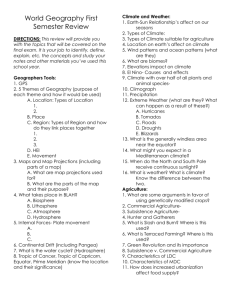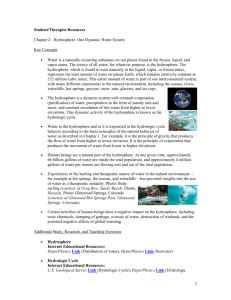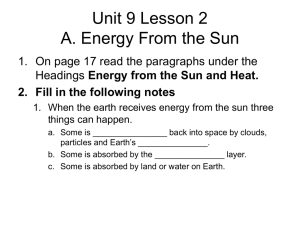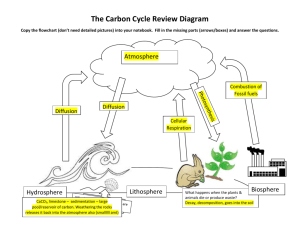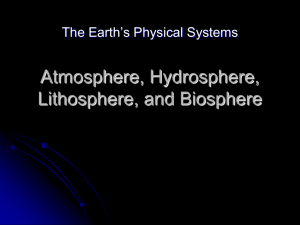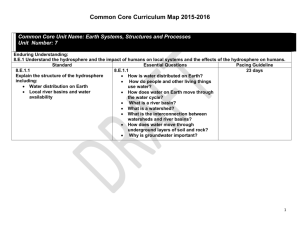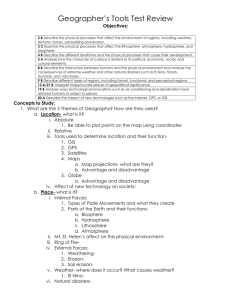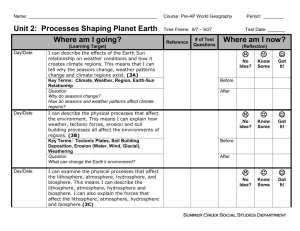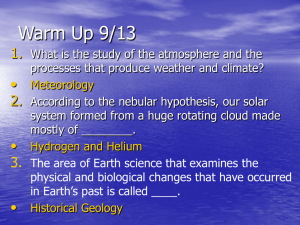Chapter 02 IR
advertisement
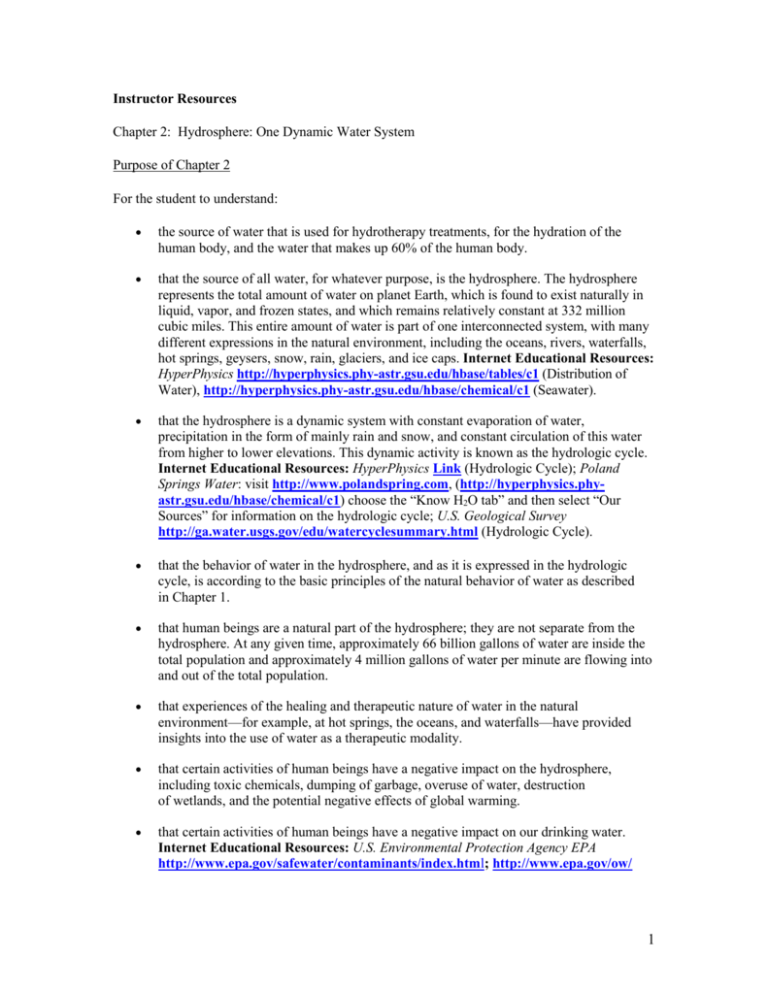
Instructor Resources Chapter 2: Hydrosphere: One Dynamic Water System Purpose of Chapter 2 For the student to understand: the source of water that is used for hydrotherapy treatments, for the hydration of the human body, and the water that makes up 60% of the human body. that the source of all water, for whatever purpose, is the hydrosphere. The hydrosphere represents the total amount of water on planet Earth, which is found to exist naturally in liquid, vapor, and frozen states, and which remains relatively constant at 332 million cubic miles. This entire amount of water is part of one interconnected system, with many different expressions in the natural environment, including the oceans, rivers, waterfalls, hot springs, geysers, snow, rain, glaciers, and ice caps. Internet Educational Resources: HyperPhysics http://hyperphysics.phy-astr.gsu.edu/hbase/tables/c1 (Distribution of Water), http://hyperphysics.phy-astr.gsu.edu/hbase/chemical/c1 (Seawater). that the hydrosphere is a dynamic system with constant evaporation of water, precipitation in the form of mainly rain and snow, and constant circulation of this water from higher to lower elevations. This dynamic activity is known as the hydrologic cycle. Internet Educational Resources: HyperPhysics Link (Hydrologic Cycle); Poland Springs Water: visit http://www.polandspring.com, (http://hyperphysics.phyastr.gsu.edu/hbase/chemical/c1) choose the “Know H2O tab” and then select “Our Sources” for information on the hydrologic cycle; U.S. Geological Survey http://ga.water.usgs.gov/edu/watercyclesummary.html (Hydrologic Cycle). that the behavior of water in the hydrosphere, and as it is expressed in the hydrologic cycle, is according to the basic principles of the natural behavior of water as described in Chapter 1. that human beings are a natural part of the hydrosphere; they are not separate from the hydrosphere. At any given time, approximately 66 billion gallons of water are inside the total population and approximately 4 million gallons of water per minute are flowing into and out of the total population. that experiences of the healing and therapeutic nature of water in the natural environment—for example, at hot springs, the oceans, and waterfalls—have provided insights into the use of water as a therapeutic modality. that certain activities of human beings have a negative impact on the hydrosphere, including toxic chemicals, dumping of garbage, overuse of water, destruction of wetlands, and the potential negative effects of global warming. that certain activities of human beings have a negative impact on our drinking water. Internet Educational Resources: U.S. Environmental Protection Agency EPA http://www.epa.gov/safewater/contaminants/index.html; http://www.epa.gov/ow/ 1 (Safe Drinking Water), AP Research on Drugs in Drinking Water: use your favorite search engine to find articles on “research on drugs in drinking water.” http://www.innovativespa.com/waterdrugs.htm Lesson Plan: The Hydrosphere and Hydrologic Cycle Have the students read the chapter and then discuss the chapter in a classroom session. Refer to the textbook for detailed information for the discussion and teaching exercises discussed next. 2 Discuss the nature of the hydrosphere, that it has a relatively fixed amount of water that is found in different natural expressions in the environment, including the oceans, rivers, waterfalls, hot springs, geysers, snow, rain, glaciers, ice caps, and so on. Discuss why the hydrosphere is one dynamic, integrated system. See accompanying NASA photos that show the Earth and the hydrosphere. The photos provide a visual understanding of the hydrosphere. Discuss the hydrologic cycle and its role in purifying and distributing water to all regions of the globe. Discuss the behavior of water in the hydrosphere and as it is expressed in the hydrologic cycle; it behaves according the basic principles of the natural behavior water. Have the students provide as many examples of this as possible. For example, it is the principle of gravity operating on water that brings water from higher to lower elevations. It is the principle of evaporation of water that brings water from lower elevations to higher elevations. It is the principle of water as a solvent that allows oxygen, carbon dioxide, and minerals to dissolve in the water as water passes through the atmosphere and soil. Figure 2–2 The hydrologic cycle (courtesy of U.S. Department of the Interior/U.S. Geological Survey). Discuss why human beings are a natural part of the hydrosphere. Why are all living systems connected to the hydrosphere, the one water system on the planet? Discuss how people can gain experience and knowledge of the therapeutic value of water from experiences of water in natural settings—for example, hot springs, the ocean, rivers, waterfalls, snow, and ice. Have the students give some examples as well as any experiences they may have. Figure 2–5 Body surfing (courtesy of Greg Rice, Sandy Beach, Oahu, Hawaii). Exercise: Have the students create a dynamic model of the hydrologic cycle as described in Teaching Exercise 2−1. Discuss how each aspect of the hydrologic cycle can be found in this model. Exercise: Have the students research the source, treatment procedures, distribution, and other important aspects of the local municipal water supply. Discuss what home water purification systems should be used to further purify the local municipal water coming into residential homes to make it safe for drinking. There is really no one correct approach for this, and there are many opinions on what is needed, but it is an interesting topic that can provoke a meaningful discussion. Exercise: In a classroom setting, or on a home computer, have the students view the different NASA photos of planet Earth’s key elements of the hydrosphere and the hydrologic cycle. (These photos are also in the student/reader section.) 1. The hydrosphere is one interconnected system. 2. Show the dynamic elements of the hydrologic cycle: surface water (for example, oceans, rivers, lakes, ice caps) and clouds. Using examples in the photos—for example, the rainforest in the Amazon—show how all living systems are connected to the same hydrosphere. 3. Show how pollution of the hydrosphere by people in any country can affect the total hydrosphere and all living systems connected with it. NASA Photos of the Hydrosphere Australia http://www.study hydrotherapy.com/ EarthAustralia14 Inch.jpg South America, Africa, Middle Central America, East, Europe Caribbean http://www.study hydrotherapy. com/EarthSouth America14Inch. jpg Antarctica North America, Northern Ice Cap http://www.study http://www.study http://www.study hydrotherapy.com/ hydrotherapy. hydrotherapy. com/EarthAfrica com/south_2.jpg EarthforHydroTour. JPG 14Inch.jpg *All Links to HyperPhysics appear courtesy of: Copyright HyperPhysics (©C.R. Nave, 2006) REVIEW QUESTIONS & ANSWERS 1. Describe the hydrosphere. Answer: The hydrosphere refers to all the water on Earth, which is a fixed amount of approximately 322,500,000 cubic miles. All this water is part of one interconnected system, with different natural dynamic expressions—for example, the oceans, lakes, rivers, waterfalls, hot springs, snow, rain, and ice caps. 2. Describe the hydrologic cycle. Answer: All of the water in the hydrosphere is involved in a continual dynamic process of evaporation (purification), condensation (clouds), rain and snow (precipitation), and flow of water from higher to lower elevations. 3. Why is the hydrosphere considered one interconnected water system? Answer: Because there is a fixed amount of water on Earth that behaves as one system. The functioning of the hydrosphere is an example of this. 3 4. Why are human beings a natural part of the hydrosphere? Answer: All living organisms, including human beings, are mainly made up of water. Approximately 66 billion gallons of water are inside the total population of human beings at any given time. 5. Give an example of how knowledge of the use of water for hydrotherapy could have been gained from the experience of water in natural settings. Answer: Bathing in natural hot springs could produce the healing benefits of detoxification and increased speed of healing. 6. What are some everyday uses of water from sources in the hydrosphere? Answer: See Figure 2-6. A few examples are for agriculture, hydration, bathing, and cleaning. 7. What are some of the recreational uses of water? Answer: See Figure 2-6. A few examples are swimming, skiing, and boating. 8. List several ways human activity is damaging the hydrosphere. Discuss different ways to reduce or eliminate these problems. Answer: Toxic chemical pollution of water from industry and dumping of garbage in water systems, including the ocean, is harming the hydrosphere. Education and government regulation are two main ways to control these problems. 9. Discuss how water, on a global scale, is purified by the hydrologic cycle and is naturally distributed to every region on Earth. Answer: Evaporation of water from surface water on the Earth causes all of the water molecules to separate and rise into the atmosphere, where they will later condense to form pure water in the form of rain and snow. However, as the water comes into contact with pollution in the air and land, these substances may dissolve or mix with the water. 10. List several ways water is treated to make it safe for drinking, both by municipal treatment plants and by residential water purification systems. Answer: Municipal water treatment removes sediment in the water and chemical treatment kills germs in the water. 4

